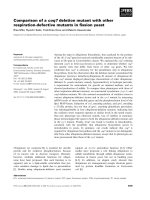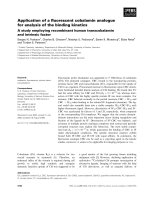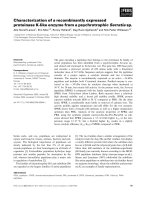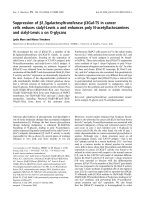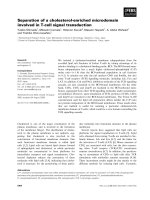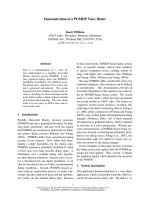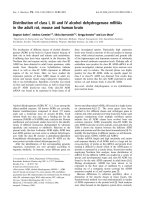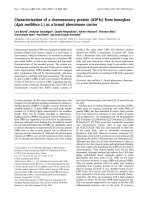Báo cáo khoa học: Suppression of a cold-sensitive mutant initiation factor 1 by alterations in the 23S rRNA maturation region pdf
Bạn đang xem bản rút gọn của tài liệu. Xem và tải ngay bản đầy đủ của tài liệu tại đây (322.27 KB, 12 trang )
Suppression of a cold-sensitive mutant initiation factor 1
by alterations in the 23S rRNA maturation region
Jaroslav M. Belotserkovsky, Georgina I. Isak and Leif A. Isaksson
Department of Genetics, Microbiology and Toxicology, Stockholm University, Sweden
Introduction
Bacterial protein synthesis, as directed by the action of
the ribosome, can be broadly divided into four main
phases – initiation, elongation, termination, and recy-
cling. Initiation is the rate-limiting step [1]. This phase
is mediated by initiation factor 1 (IF1), initiation fac-
tor 2, and initiation factor 3. IF1 is the smallest of the
initiation factors [2]. Its structure has been determined
by NMR spectroscopy, revealing that IF1 is a member
of the oligomer-binding (OB-fold) family of proteins,
with structural similarities to cold shock proteins [3].
In addition, IF1 has been shown to complement
lesions in several cold shock response proteins in Bacil-
lus subtilis [4]. The interaction of IF1 with the bacterial
ribosome has been investigated by chemical probing
[5], mutagenesis studies [6], and crystallography [7,8].
These data indicate that IF1 makes contacts with the
functionally important bases G530, A1492 and A1493
in 16S rRNA. In addition to its direct involvement in
translation initiation [1], IF1 has been shown to be an
RNA chaperone [9], as well as playing a role in tran-
scriptional antitermination in Escherichia coli [10].
More recently, it has been reported that IF1 acts as a
sensor of cis-elements in mRNA [11] and, together
with initiation factor 3, determines the rates of ribo-
somal subunit joining by inducing conformational
changes in the 30S subunit [12].
Each of the seven rRNA operons in E. coli is tran-
scribed as a single primary transcript. The order of
gene products relative to the start of transcription is
16S, 23S, and 5S, with some tRNA species between
16S and 23S as well as at the end of the transcript. As
transcription proceeds, the rRNA forms secondary
structures that are substrates for the binding of ribo-
somal proteins and maturation factors [13]. Among
these structures are double-stranded stems that are
composed of terminal flanking sequences of 16S and
23S rRNAs. These ‘processing’ stems are substrates for
RNase III, and other ribonucleases that trim the stems
Keywords
Escherichia coli; RNase III; rRNA mutation;
rRNA processing; translation
Correspondence
L. A. Isaksson, Department of Genetics,
Microbiology and Toxicology, Stockholm
University, S-10691 Stockholm, Sweden
Fax: +46 8 164315
Tel: +46 8 164197
E-mail:
(Received 24 January 2011, revised 1 March
2011, accepted 14 March 2011)
doi:10.1111/j.1742-4658.2011.08099.x
Genetic selection has been used to isolate second-site suppressors of a
defective cold-sensitive initiation factor I (IF1) R69L mutant of Escherichia
coli. The suppressor mutants specifically map to a single rRNA operon on a
plasmid in a strain with all chromosomal rRNA operons deleted. Here, we
describe a set of suppressor mutations that are located in the processing stem
of precursor 23S rRNA. These mutations interfere with processing of the 23S
rRNA termini. A lesion of RNase III also suppresses the cold sensitivity.
Our results suggest that the mutant IF1 strain is perturbed at the level of
ribosomal subunit association, and the suppressor mutations partially com-
pensate for this defect by disrupting rRNA maturation. These results support
the notion that IF1 is an RNA chaperone and that translation initiation is
coupled to ribosomal maturation.
Abbreviations
Amp, ampicillin; Cm, chloramphenicol; IF1, initiation factor 1; Kan, kanamycin; Tet, tetracycline; TIR, translation initiation region.
FEBS Journal 278 (2011) 1745–1756 ª 2011 The Authors Journal compilation ª 2011 FEBS 1745
to eventually produce mature rRNA termini [14,15].
The processing of 23S rRNA is strictly dependent on
the action of RNase III. A deletion in the gene encod-
ing this enzyme results in immature 23S rRNA with
extended termini, whereas 16S rRNA is matured to
completion [16].
There is ample evidence that the maturation of the
two ribosomal subunits is interdependent, and that
subunit maturation events are functionally linked to
translation initiation [13]. Here, we have isolated muta-
tions in the 23S rRNA processing stem that suppress a
cold-sensitive mutant of IF1. This serves as additional
evidence that ribosome maturation and translation
initiation are intimately linked.
Results
Mutations in the processing stem of 23S rRNA
The existence of D7 E. coli strains, in which all seven
rRNA operons are deleted, has facilitated studies with
rRNA that exists as genetically pure populations of
cellular ribosomes. This is possible because a plasmid
with any one of these genes can compensate for the
deleted rRNA genes. We have used such a strain in
order to select for mutations in rRNA that suppress
the cold-sensitive phenotype of a mutant IF1 (R69L).
This mutation in IF1 leads to significant growth inhibi-
tion at low temperatures [17]. A D7 strain containing
IF1R69L was screened for spontaneous revertants that
were cold-resistant at the nonpermissive temperature
of 23 °C. We specifically sought revertants that carried
second-site suppressor mutations on the plasmid-
encoded rRNA operon. Here we report a set of sup-
pressor mutations that are located in the 23S rRNA
processing stem (Fig. 1). This structural region is sub-
ject to cleavage by RNase III and other ribonucleases
during 23S rRNA maturation [16]. In particular, the
positions of mutated residues overlap with known
RNase III cleavage sites [18]. The same base was
found to be mutated in the mutant plasmids pD1 (G
to T) and pD6 (G to A) as a result of independent
selections, indicating that such suppressors are com-
mon in this structure (Fig. 1). When plasmids with the
mutated rrnB gene were introduced into the IF1
mutant strain JB69, thus providing the sole source of
rRNA, noticeable growth enhancement was observed
on solid medium as well on as rich liquid medium
upon downshift to the nonpermissive temperature of
23 °C (Figs 2A and 3). It should be noted that the
R69L mutation is not lethal in the downshift condi-
tion, but merely deleterious. This explains why JB69
continued to grow, albeit slowly, following the down-
shift (Fig. 3). The obvious question was whether these
mutations have any effect on 23S stem processing. Pri-
mer extension analyses were used to check the termini
of 23S rRNA from total cellular extracts in these
mutants. Additional bands corresponding to accumula-
tion of precursors of 23S rRNA in mutant plasmids
were detected (Fig. 4A). The expected 5¢ mature and
)7 termini, as well as additional bands corresponding
to approximate )41 (e1) and )46 (e2) termini, were
identified in strains carrying the mutant plasmids. pD1
and pD6, which carry mutations on the 5¢-side of the
processing stem, gave rise to rRNA with the majority
of termini in the mature form, whereas pD3, with a
mutation on the 3¢-side, gave rise rRNA with the
majority of the termini in the )7 form. In addition, for
Fig. 1. Secondary structure of 23S rRNA processing stem, show-
ing sites of suppressor mutations. Cleavage sites of RNase III on
naked RNA (solid arrows) and on the ribosome (dashed arrows) are
indicated. The sequence of mature termini of 23S rRNA is in bold.
Sites of mutations are encircled. Mutants are designated as fol-
lows: pD1 and pD6 carry mutations in position G8, and are G to T
and G to A substitutions, respectively. pD3 has a C to A substitu-
tion at position C + 2. Figure reproduced from [18].
Processing stem mutations suppress cold-sensitive IF1 J. M. Belotserkovsky et al.
1746 FEBS Journal 278 (2011) 1745–1756 ª 2011 The Authors Journal compilation ª 2011 FEBS
pD1, the e1 ()41) terminus was more prominent. Thus,
there were apparent differences between the mutant
plasmids in extended termini, depending on the
mutated position in the processing stem. Taken
together, these results suggest that the processing stem
mutations block nucleolytic processing, most likely by
RNase III or other RNases; however, the blockage is
incomplete, as shown by the existence of mature 23S
termini in all mutants. As these mutations were iso-
lated as suppressors of a cold-sensitive IF1 mutant, we
considered the remote possibility that IF1 has some
involvement in the processing of this structure. We
reasoned that, if IF1 has such a role, we would detect
differences in the relative amounts of bands corre-
sponding to mature 23S and other extended termini
when total cellular RNA was extracted at the nonper-
missive temperature of 23 °C and when it was
extracted at 37 °C. Processing of mutant plasmids was
compared with that of the wild type in both JB69 and
SQZ10, using total RNA extracted from cells grown at
23 °C and 37 °C. No significant differences were
found, indicating that processing stem mutations affect
the processing of 23S rRNA irrespective of incubation
temperature or strain background (not shown).
Lack of processing suppresses the IF1 cold
sensitivity phenotype
Next, we investigated whether the suppression pheno-
type results from the nature of the 23S processing stem
mutations themselves, or whether a general lack of 23S
processing stem maturation would result in the same
phenotype. To this end, we generated a large deletion
in the ORF of rnc, a gene encoding RNase III, in the
cold-sensitive JB69 and CVR69L strains. The deletion
was designed such that only the first 15 and last 38
amino acids were left intact in the ORF. The reason
was to avoid potential disruption or polar effects on
the downstream and overlapping ORF that encodes
the essential Era GTPase [19]. We found that the
RNase III lesion in JB69 resulted in the same apparent
phenotype as the 23S processing stem mutations when
Fig. 2. Phenotype of cold-sensitive IF1 mutants with various suppressors. (A) A plate incubated at 23 °C for 72 h with the D7-derived
strains, where: IF1 is pKK3535 ⁄ JB69; IF1Drnc is pKK3535 ⁄ JB69Drnc; IF1 + pD1, pD3 and pD6 are suppressor plasmids pD1, pD3 and pD6
in JB69, respectively. (B) A plate incubated at 20 °C for 72 h with the MG1655-derived strains, where: IF1 is CVR69L; IF1Drnc is
CVR69LDrnc.
Fig. 3. Growth properties of suppressor, wild-type and IF1 strains
in rich liquid medium. Cultures were grown to D
590 nm
0.2 at 37 °C,
after which they were shifted to 23 °C (shown as dotted line).
Growth trajectories of strains are labeled as follows: ¤,
pKK3535 ⁄ SQZ10; j, pD3 ⁄ JB69; m, pKK3535 ⁄ JB69;
•
, pKK3535 ⁄
JB69Drnc. Suppressor plasmids pD1 and pD6 in JB69 are omitted
for clarity, as they have identical trajectories to pD3 ⁄ JB69. Straight
lines were fitted to data generated from at least three independent
experiments.
J. M. Belotserkovsky et al. Processing stem mutations suppress cold-sensitive IF1
FEBS Journal 278 (2011) 1745–1756 ª 2011 The Authors Journal compilation ª 2011 FEBS 1747
the strain was grown on solid medium (Fig. 2A). How-
ever, in rich liquid medium, the suppression effect was
less apparent for this strain (Fig. 3). It can be seen
that, in these culture conditions, the rnc strain had a
different growth trajectory from the processing stem
mutants (pD3). This suggests that the RNase III-
dependent suppressor may act in a different manner
from the processing stem mutations. As a deletion in
rnc acts as a suppressor of JB69, a D7-derived IF1
mutant strain, it was of interest to determine whether
this deletion would also give rise to a similar suppres-
sion phenotype in the MG1655 (wild type)-derived IF1
mutant strain CVR69L. Indeed, we observed weak but
obvious growth enhancement of CVR69L carrying a
lesion in RNase III as compared with the CVR69L
mutation alone at 20 °C (Fig. 2B). This indicates that
the suppression phenotype (on solid medium) is allele-
specific, depending on the presence or absence of RNa-
se III. Figure 4B shows primer extension analysis of
the 5¢-terminus of 23S rRNA in strain JB69Drnc.
There were various extended termini, with the major
extension products corresponding to an approximate
Fig. 4. Primer extension analysis of 5¢-termini of 23S rRNA from mutant strains. (A) Extension products from total cellular RNA. (B) Compari-
son of processing stem mutant plasmid extension products and the RNase III deletion strain (Drnc). (C) Extension products from sucrose
gradient fractions, where 50 and 70 are fractions corresponding to the 50S and 70S subunit peaks. Plasmids and strains are as follows:
pKK3535 is the wild-type rrnB+ plasmid; pD1, pD3 and pD6 are processing stem mutant plasmids; SQZ10 is the wild-type strain (IF1wt);
JB69 is the IF1 mutant strain (IF1R69L); JB69Drnc is the IF1 mutant with a deleted RNase III gene. Extension products are labeled as fol-
lows: M is mature 23S rRNA (55 bases long); )3 and )7 are immature 23S rRNA extension products; e1 and e2 are additional immature
extension products observed in processing stem mutant strains (41 and 46 bases, respectively); e3 is the RNase III lesion-specific extension
product (24 bases). Sizes of marker lane products are given in (A). The tables below (A) and (C) show quantification of extension products
for each corresponding panel calculated by
IMAGE analysis software.
Processing stem mutations suppress cold-sensitive IF1 J. M. Belotserkovsky et al.
1748 FEBS Journal 278 (2011) 1745–1756 ª 2011 The Authors Journal compilation ª 2011 FEBS
)24 (e3) terminus as well as the )46 terminus, as is the
case with the processing stem mutants. Interestingly,
there was a total absence of a fully mature 23S termi-
nus; instead, a slightly truncated product was
observed. To rule out any possible involvement of Era
in cold sensitivity suppression of mutant IF1, we
cloned the era ORF (which is immediately downstream
of rnc) under control of an isopropyl thio-b-d-galacto-
side-inducible promoter. No cold sensitivity suppres-
sion was observed either with or without isopropyl
thio-b-d-galactoside induction when the era plasmid
was introduced into CVR69L (not shown). In fact,
overexpression of Era was deleterious at both 20 °C
and 37 °C, consistent with another report [20]. The
corresponding experiment could not be performed in
JB69, owing to the presence of multiple plasmids in
this strain. Taken together, our results suggest the
RNase III deletion results in suppression of cold sensi-
tivity JB69, probably as a result of incomplete matura-
tion of 23S rRNA, as is also the case with the
processing stem mutants. However, other effects asso-
ciated with this lesion could also account for the
suppressor phenotype.
The IF1 mutant has an altered sucrose gradient
ribosomal profile when shifted to 23
°
C
Having shown that processing of rRNA is involved in
the suppression phenotype, we next examined how
such processing defects would affect sucrose gradient
ribosomal profiles of the mutant strains. As the sup-
pressor effect is manifested in the cold, we employed a
temperature downshift from 37 °Cto23°C during cul-
turing before examining the ribosome profiles. During
the course of these experiments, we noted that, upon
downshift to the nonpermissive temperature of 23 °C,
there were clear differences between the sucrose gradi-
ent ribosomal profiles of the IF1 mutant and wild-type
strains. In particular, in the case of JB69, there
appeared to be a slight decrease in the proportion of
free ribosomal subunits and a concurrent relative
increase in the 70S ribosomes as compared with
SQZ10 (Fig. 5), suggesting that JB69 is perturbed at
the level of subunit association in the cold. It is known
that the Mg
2+
concentration influences ribosome sub-
unit association. As the differences are rather subtle,
the sucrose gradient experiments were carried out at
several Mg
2+
concentrations. Following a downshift
to 23 °C, we lysed the cells in a 6 mm Mg
2+
buffer,
and applied them to sucrose gradients with varying
Mg
2+
concentrations from 6 mm to 20 mm. We also
performed experiments in which cells were lysed in
10 mm Mg
2+
buffer and applied to the same gradients,
with similar results (not shown). First, both the
sucrose gradient profiles and the accompanying quanti-
fication suggest that JB69 exhibits a decreased ratio of
free 30S and 50S subunits relative to 70S particles as
compared with SQZ10. Thus, throughout the Mg
2+
titration range, there was an increased proportion of
70S particles relative to the free subunits. This was evi-
dent when looking at the amount of 30S subunits that
were incorporated into the 70S particles as a percent-
age of the total amount of 30S (value a in Fig. 5). In
SQZ10, this value ranged from 33% to 58% through-
out the Mg
2+
titration range, whereas in JB69, it ran-
ged from 50% to 60% at the same Mg
2+
concentrations. When the traces and the quantification
of peak areas in JB69 and SQZ10 were examined, it
appeared that there was a stoichoimetric imbalance of
30S and 50S subunits, whereby the 30S subunits were
in excess in JB69. This was noticeable at lower Mg
2+
concentrations, when only 33% of the subunits (30S)
were in the 70S particles in SQZ10, as compared with
50% in JB69. However, there was little difference in
the stoichiometric amounts of 30S and 50S subunits
between these two strains in the 20 mm Mg
2+
titration
– a condition where most of the 30S and 50S subunits
were in the 70S particles (approximately 60%) in both
strains. In addition, the apparent ratio of 30S to 50S
subunits in SQZ10 varied with increasing Mg
2+
con-
centration. Thus, the observed difference may reflect
the limitations in quantifying the peak areas of traces
when most of the free subunits are in the 70S trace, as
was the case with JB69 throughout the Mg
2+
titration,
and with SQZ10 at high Mg
2+
conentrations. Taken
together, the data suggest that JB69 has an increased
amount of 70S particles relative to the free subunits in
the cold, and that this effect is probably not attribut-
able to stoichiometric imbalances of the 30S and 50S
subunits. The same analysis revealed that there was a
general decrease in the amount of 50S subunits in the
sucrose gradient in the case of the suppressor plasmid
pD3. In particular, there was a consistent increase in
the 30S ⁄ 50S ratio of approximately 15% when pD3
was the sole source of rRNA in either SQZ10 or JB69.
This suggests that there was a stoichiometric imbalance
of 30S and 50S particles, whereby 30S was in excess.
This effect was strain background-independent, and
occurred throughout the Mg
2+
titration range (com-
pare traces and 30S ⁄ 50S ratios of pD3 to pKK3535 in
each strain background). In addition, whenever pD3
was the sole source of rRNA, there was a slight
decrease in the degree of subunit association in both
SQZ10 and JB69 (compare value a in the correspond-
ing traces). Finally, when traces of the rnc lesion strain
(JB69Drnc) were examined, it was apparent that there
J. M. Belotserkovsky et al. Processing stem mutations suppress cold-sensitive IF1
FEBS Journal 278 (2011) 1745–1756 ª 2011 The Authors Journal compilation ª 2011 FEBS 1749
was a decrease in the total amount of ribosomal parti-
cles (30S, 50S, and 70S) as compared with all other
traces, even though the same amount of material was
applied to the gradients. This decrease was consistent
and occurred throughout the Mg
2+
titration. This sug-
gests that the total pool of ribosomes in this strain is
decreased, most likely as a result of improper matura-
tion of rRNA. However, this effect could also be
growth rate-related, as JB69Drnc has a long lag phase
in the downshift condition (Fig. 3). Interestingly, the
Fig. 5. Sucrose gradient profiles of ribosomes at different Mg
2+
concentrations. Each column is designated with the respective strain,
where: pKK3535 is the wild-type rrnB+ plasmid; pD3 is a processing stem mutant plasmid; SQZ10 is the wild-type strain (IF1wt); JB69 is
the IF1 mutant strain (IF1R69L); JB69Drnc is the IF1 mutant with a deleted RNase III gene. Rows are designated with the corresponding
Mg
2+
concentration in the gradient. Identities of the peaks are as indicated in the left gradient, second row. a is the molar proportion of 30S
subunits that are in 70S ribosomes over total 30S subunits [70S ⁄ (30S + 70S)], as a means of quantifying the extent of subunit association. b
is the molar ratio of total 30S to 50S subunits (30S ⁄ 50S). Quantification is based on peak areas, whereby the 30S ⁄ 50S ⁄ 70S molar ratio is
adjusted to 1 : 1.96 : 2.96 of the peak areas. Each experiment was carried out three times. The a and b values are given as means of these
experiments, where the standard deviation does not exceed 10% of the value. The figure is generated by the use of
FYTIK software from
raw data with a representative gradient profile.
Processing stem mutations suppress cold-sensitive IF1 J. M. Belotserkovsky et al.
1750 FEBS Journal 278 (2011) 1745–1756 ª 2011 The Authors Journal compilation ª 2011 FEBS
apparent extent of subunit association was greater in
the RNase III deletion strain than in JB69 throughout
the Mg
2+
titration range. Taken together, the results
suggest that the effect of the processing stem suppres-
sor mutations is to lower the available pool of mature
50S subunits as a result of incomplete 23S rRNA mat-
uration. As a consequence, there is a decrease in the
extent of subunit association, as suggested in Fig. 6. In
the case of the Drnc strain, this effect might have
resulted from decreases in the cellular pool of both
the 30S and 50S subunits, because of disruption of the
primary rRNA transcript maturation.
As the analysis was carried out with D7 strains,
we were concerned that the observed increased sub-
unit association in the case of JB69 was an artefact
resulting from the altered genetic background.
Indeed, it appeared that the parental strain SQZ10
was somewhat perturbed at the level of subunit asso-
ciation in the conditions used here. To settle this, we
examined sucrose gradient profiles of the original
CVR69L IF1 mutant and its parental wild-type
strain, MG1655, when subjected to the same down-
shift to 23 °C (Fig. 7). Here, a similar profile was
observed as in the case of JB69 as compared with
SQZ10. There was an increase in the relative amount
of 70S particles as compared with free subunits, indi-
cating that the observed aberrant profile is not
strain-specific, but is a function of the mutant IF1
allele.
Fig. 6. A model of possible mechanism of suppression of IF1R69 mutant by 23S processing stem mutations. (A) Effect of the mutant
IF1R69L on subunit association in the cold. The forward reaction of subunit association ⁄ dissociation is favored (bold forward arrow). (B) Out-
come when processing stem mutations interfere with 23S rRNA processing. This results in a decreased cellular pool of properly matured
50S subunits, favoring the reverse reaction of subunit association ⁄ dissociation (bold reverse arrow). III indicates sites of processing by RNa-
se III. X indicates RNase III sites blocked because of processing stem mutations.
Fig. 7. Sucrose gradient profile of ribosomes from MG1655 (IF1wt)
and CVR69L (IF1R69L). For this experiment, cells were lysed and
analyzed on gradients with 10 m
M Mg
2+
. Profiles are representative
of three independent experiments.
J. M. Belotserkovsky et al. Processing stem mutations suppress cold-sensitive IF1
FEBS Journal 278 (2011) 1745–1756 ª 2011 The Authors Journal compilation ª 2011 FEBS 1751
Immature 23S rRNA termini are present in both
the 50S and the 70S fractions
We then investigated whether the observed extended
termini present in the 23S processing stem mutants
were incorporated into the 50S subunits and 70S
translating ribosomes. To this end, we purified rRNA
from sucrose gradient fractions and checked the state
of processing of 23S rRNA termini by primer exten-
sion. It can be seen in Fig. 4C that when the suppres-
sor mutant plasmid pD3 was present in either SQZ10
or JB69, a significant proportion of 23S termini from
both the 50S and 70S peaks were in the immature
form, where the )7 species predominates. The e2
extension species was also prevalent, and other minor
extension products were observed. In the presence of
the suppressor plasmid, as little as 13% of the normal
23S 5¢-terminus was in the fully mature form. In con-
trast, when the wild-type plasmid pKK3535 was the
sole source of rRNA in either SQZ10 or JB69, as
much as 59% of the termini were in the fully mature
form, with the )7 and, to a lesser extent, the )3 spe-
cies accounting for the rest. This was the case when
rRNA was purified from cells grown at 37 °C, as well
from those grown at 23 °C. This indicates that imma-
ture extended 23S rRNA termini were incorporated
into the 50S subunits and functional 70S ribosomes,
irrespective of strain background or incubation tem-
perature. It is worth noting that, in the case of the
wild-type pKK3535 plasmid in either SQZ10 or JB69,
there was a slight but consistent difference between the
extension products from the 50S and 70S fractions,
respectively. In particular, there was an increase in the
relative amount of the fully mature terminus, with a
concurrent decrease of the ) 7 species in the 70S frac-
tion as compared with the 50S fraction. This suggests
that final maturation of 23S rRNA occurs on translat-
ing ribosomes, in agreement with other reports [13].
This effect was less apparent in the case of the sup-
pressor plasmid pD3, suggesting that extended 23S
rRNA termini are not fully matured on the translating
ribosome.
Other defects in 50S subunit maturation do not
rescue cold sensitivity of mutant IF1
As we had established that processing defects in 23S
rRNA act as suppressors of a cold-sensitive IF1 mutant,
we reasoned that other similar defects in 50S maturation
as a whole may have the same effect. To check this
possibility, we moved, by P1 transduction, deletions in
genes that have been shown to be involved in 50S
maturation into the cold-sensitive IF1 mutant strains.
Specifically, we focused on the genes deaD, dbpA, and
srmB, encoding 23S rRNA helicases DeaD, DbpA, and
SrmB respectively [21–23]. Deletions in these genes (one
at a time) were introduced, by P1 transduction from
KEIO collection donor strains, into CVR69L as well as
JB69, and checked for cold sensitivity suppression [24].
No such suppression was observed when the con-
structed strains were grown at the nonpermissive tem-
perature of 23 °C. This indicates that the suppressive
effect of processing stem mutants was not a function of
general defects in 50S subunit maturation, but was
specific to processing of 23S rRNA termini.
On the basis of our results, we suggest that the dif-
ference observed in sucrose gradient ribosome profiles
between the IF1 mutant and wild-type strains is attrib-
utable to a relative increase in the proportion of 70S
ribosomes, and a concurrent decrease in the propor-
tion of the free ribosomal subunits (Fig. 6A). Taken
together, these results indicate that at least one of the
manifestations of the growth defect in the IF1 mutant
at nonpermissive temperatures is at the level of ribo-
somal subunit joining. One class of suppressor muta-
tions that specifically alter 23S rRNA processing
partially restores the growth defect by affecting the
30S to 50S stoichiometry.
Discussion
Although IF1 has been the focus of studies for a few
decades, there is still a considerable amount of interest
in this small initiation factor, largely because it is essen-
tial for growth and has been found in all organisms
investigated. With the knowledge gained from struc-
tural and mutagenic studies [6,7], as well as the more
recent data indicating that IF1 is an RNA chaperone
[9,10], all of which demonstrate that IF1 interacts with
RNA, we set out to find functional interactions that
IF1 may undergo with rRNA. We employed a simple
genetic approach to isolate second-site suppressor
mutations that map to rRNA and that suppress a cold-
sensitive IF1 mutant strain. Such suppressor mutations
should reveal the interactions between IF1 and rRNA
that have not been evident from crystallographic or
other studies. Contrary to our initial expectations, the
first set of suppressor mutations were found to be
located in the 23S rRNA processing stem, and not in
the structural part of the mature rRNA. Our data sug-
gest that the mechanism of suppression of cold sensitiv-
ity in these double mutants is indirect, resulting from
rRNA maturation defects. According to structural
data, the mature form of the processing stem of 23S
rRNA (helix 1) is not proximal to the subunit interface
of 50S, suggesting that direct contacts between IF1 and
Processing stem mutations suppress cold-sensitive IF1 J. M. Belotserkovsky et al.
1752 FEBS Journal 278 (2011) 1745–1756 ª 2011 The Authors Journal compilation ª 2011 FEBS
helix 1 on the ribosome are unlikely. The notion of
indirect suppression was further supported by the
observation that a lesion in RNase III, the enzyme
responsible for initial cleavage of the processing stem,
also suppresses the IF1 defect. On the other hand, the
effect of the RNase III lesion was different from that
of processing stem mutations with respect to the sup-
pression effect in rich liquid medium. As RNase III has
multiple RNA targets in the cell, it is possible that, in
this case, the suppressor effect is, in fact, not directly
related to the processing of rRNA. However, such
effects cannot explain the mode of suppression of the
23S rRNA processing stem mutants.
On the basis of the sucrose gradient data, we suggest
that the mutant IF1, when shifted to the nonpermissive
temperature, leads to an altered rate of subunit associa-
tion ⁄ dissociation, at the expense of some functional
conformational change, presumably in the 30S subunit.
Several lines of evidence support this. First, it is known
from structural studies that IF1 induces conformational
changes in the 30S subunit [7,25,26]. Second, the partic-
ular R69L alteration in IF1 results in a general increase
in expression of reporter genes [27], while also leading
to increased RNA chaperoning activity as compared
with wild-type IF1 [9]. Moreover, recent data have
shown that the R69L IF1 mutation leads to increased
expression of reporter genes that is translation initiation
region (TIR)-dependent, and that the mutation shares
this effect with the antibiotic kasugamycin [11]. Third,
it has recently been demonstrated that IF1 plays a role
in subunit joining, and has the ability to discriminate
between certain mRNAs on the basis of their TIRs [12].
In addition, IF1 influences ribosomal subunit associa-
tion–dissociation rates [28], and this function is espe-
cially necessary in the cold [29]. Finally, it is known
that IF1 has a role in the cold shock response [29–32].
Taking these findings together, we suggest that the
R69L mutant of IF1 allows premature subunit joining
by either failing to discriminate between certain TIR
elements in mRNA, or inducing a conformation in the
30S subunit under nonpermissive cold shock conditions
such that the rate of association–dissociation with the
50S subunit is affected. Analogously, the mutant IF1
may be defective in recognition of TIR elements in
mRNAs that are specifically translated by cold shock
nontranslatable ribosomes, as proposed in a model by
Jones et al. [33]. In this model, cold shock conditions
induce a conformation in the ribosomes that becomes
blocked in translation initiation, whereby only specific
mRNAs with an appropriate TIR can bypass this block
and be translated. These workers have also described a
transient increase in the 70S ribosomes after a shift to a
low temperature.
On the basis of our results, we suggest that the identi-
fied 23S processing stem suppressors act by interfering
with ribosome subunit joining by limiting the pool of
available mature 50S subunits (Fig. 6B). Moreover, as a
similarly large fraction of 50S and 70S ribosomes of one
of the processing stem mutants (pD3) is composed of
immature rRNA, it seems unlikely that there exists an
active system that prevents immature 50S subunits from
entering the translating ribosome pool. Therefore, it is
also unlikely that such immature subunits are preferen-
tially degraded. Instead, assembly of ribosomal proteins
onto immature rRNA could be delayed in these
mutants, thus accounting for an apparent decrease in
the amount of ribosome subunits. Defects that affect
rRNA maturation or subunit association should lead to
a similar suppressor phenotype for the R69L mutant
IF1. On the other hand, we found that general defects in
50S subunit maturation, when deletions in known 23S
helicases were introduced into the IF1 mutant, did not
rescue the cold sensitivity. In addition, one would expect
there to be many more potential targets for suppressor
mutations in the 23S structural gene that may interfere
with some step in 23S maturation, 50S assembly, and
subsequent subunit joining, besides those that affect the
23S processing stem. After an extensive selection, we
were not able to find any such suppressor mutations in
the structural part of 23S rRNA. We have, however,
isolated other suppressor mutations that map to the 16S
rRNA structural gene. These were found in helices 18,
20, 32, 34 and 41 in 16S rRNA. Preliminary data indi-
cate that these mutations interfere with 16S rRNA
processing and subunit association (to be published else-
where). In conclusion, we show a functional interaction
between IF1 and the processing stem of 23S rRNA. Our
results suggest that ribosomal maturation and transla-
tion are closely linked processes.
Experimental procedures
Bacterial strains and plasmids
The strains and plasmids used in this study are listed in
Table 1. All strains were grown in LB medium supplemented
with ampicillin (Amp) 200 lgÆmL
-1
, kanamycin (Kan) 50
lgÆmL
)1
, tetracycline (Tet) 20 lgÆmL
)1
, or chloramphenicol
(Cm) 35 lgÆmL
)1
, when necessary.
Construction of strains
SQZ10 is an E. coli strain with all seven chromosomally
encoded rRNA operons deleted (D7 strain). This strain car-
ries a Kan resistance plasmid encoding the rrnC operon, as
well as a counterselectable sacB marker [34]. E. coli strain
J. M. Belotserkovsky et al. Processing stem mutations suppress cold-sensitive IF1
FEBS Journal 278 (2011) 1745–1756 ª 2011 The Authors Journal compilation ª 2011 FEBS 1753
CAG18478 was used to transfer the Tet resistance marker
into the IF1 mutant strain CVR69L, with an arginine to
leucine substitution at position 69, by P1 transduction [17].
This strain was then used as a donor for subsequent trans-
fer of the mutant IF1 allele into SQZ10 to generate JB69.
Plasmid pKK3535 [35], containing the rrnB of E. coli and
an Amp resistance marker, was used to replace a resident
plasmid, pCsacB-KmR. PCR-based site-directed mutagene-
sis was used to introduce mutations into pKK3535.
A deletion was introduced into the gene rnc, encoding the
RNase III, with pKO3::Drnc [36]. As a result, only 15 N-ter-
minal and 38 C-terminal amino acids remained in the ORF.
The deletion fragment was constructed according to [37],
with the following primers: rnc5¢O NotI, GTCGGATC
CGCGGATCAGGTGGGGATGTATTA; rnc5¢I comp,
GGCAGTGGATGATGGGGTTCATGCGATACC; rnc3¢O
SalI, TGCGTCGACATTTGCCGCAATAGTGTCAACA;
and rnc3¢I comp, TGAACCCCATCATCCACTGCCAG
GTCAGCG. The deletion was constructed in CVR69L and
JB69 to generate CVR69LDrnc and JB69Drnc, respectively
(Table 1). A pTrc99A vector was used for cloning and over-
expression of era, encoding the GTPase Era. The primers
used were as follows: era_F_NcoI, CGACCATGGCGAAC
AGGCGTTGAAAAAAC; and era_R_SalI, CGAGTCGA
CAGCCTTCCATCGGAGTTACT. The resulting vector
was termed pTrc99a::era. Protein overexpression was
assayed by SDS ⁄ PAGE.
Selection of second-site rRNA suppressors of
cold-sensitive IF1
A direct selection procedure was used to isolate mutations in
rRNA that suppress the cold-sensitive phenotype of JB69.
Briefly, the cold-sensitive R69L mutant [17] of IF1 provided
a tool for isolation of second-site suppressors by selection at
the nonpermissive temperature. For this purpose, the mutant
allele was transferred by P1 transduction into the D7 strain
SQZ10 (Table 1). The IF1 mutant strain JB69 obtained
exhibited pronounced cold sensitivity at 23 °C. Second, the
resident pCsacB-KmR plasmid was replaced by a high copy
number plasmid, pKK3535. Stationary-phase cultures of
JB69 carrying pKK3535 were plated directly on Amp plates
at 23 °C. Colonies were pooled, and the extracted plasmid
DNA was used to transform JB69 by selecting on plates at
23 °C containing Amp and 5% sucrose to displace the resi-
dent Kan plasmid. Candidate mutants were purified, plasmid
DNA extracted, used to transform JB69 at 37 °C, and then
streaked at 23 °C to confirm that the suppressor mutations
were plasmid-borne. Successful candidates that suppressed
the cold-sensitive phenotype of JB69 were chosen, and plas-
mid DNA was sequenced after propagation in DH5a. Inde-
pendent selections were performed 10 times. To confirm the
cold sensitivity suppression effect, mutants were recon-
structed by site-directed mutagenesis.
Preparation of total RNA
The strains were grown at 37 °CinLBtoD
590 nm
0.7 or at
37 °CtoD
590 nm
0.2, and the cultures were then shifted to
the nonpermissive temperature of 23 °C and grown to
D
590 nm
0.7. Total RNA was isolated from 5-mL cultures
using the RNeasy Mini kit (Qiagen, Hilden, Germany).
Primer extension
Primer extension analysis was used to analyze the 5¢-end of
23S rRNA, with the primer extension system avian
myoblastosis virus reverse transcriptase (Promega, Madi-
son, WI, USA). Probe MRA141 (CCTTCATCGCCTCT-
GACTGCC) was labeled with [
32
P]ATP[cP] and used as a
template for the 5¢-terminus of 23S rRNA. The products of
the primer extension reaction were separated on 6% or 8%
acrylamide 8M urea sequencing gels. The gels were dried
and visualized by phosphor imaging.
Ribosome preparation and sucrose gradient
A 500-mL culture was grown in 2· LB to log phase
(D
590 nm
0.5–0.7) at 37 °C, or grown at 37 °Cto
Table 1. Bacterial strains and plasmids used in this study.
Pertinent
feature(s)
Reference
or source
Plasmids
pKK3535 rrnB, Amp, pBR322-derived [35]
pD1 pKK3535 but suppressor
of infA R69L
This work
pD3 pKK3535 but suppressor
of infA R69L
This work
pD6 pKK3535 but suppressor
of infA R69L
This work
pTrc99a Amp, pUC-derived Amersham
Pharmacia
Biotech
pTrc99a::era pTrc99a with cloned era This work
pKO3 Cm, sacB, repA (ts) [36]
pKO3::Drnc pKO3 with rnc deletion
fragment
This work
Strains
SQZ10 DrrnA, DrrnB, DrrnC, DrrnD,
DrrnE, DrrnG, DrrnH,
pCsacB-KmR, ptRNA67-SpcR
S. Quan and
C. Squires
JB69 SQZ10 but infA R69L This work
JB69Drnc JB69 but Drnc This work
MG1655 Wild-type strain [38]
CAG18478 zbj ⁄ 1230::Tn10 [39]
CVR69L MG1655 but infA R69L [17]
CVR69LDrnc CVR69L but Drnc This work
DH5
a hsdR, recA1 [40]
Processing stem mutations suppress cold-sensitive IF1 J. M. Belotserkovsky et al.
1754 FEBS Journal 278 (2011) 1745–1756 ª 2011 The Authors Journal compilation ª 2011 FEBS
D
590 nm
0.2, rapidly cooled to 23 °C in a water bath, and
then grown at 23 °C to log phase. Cells were chilled, and
harvested by centrifugation at 4000 g for 15 min. The cells
were destroyed by energetic rubbing, using Al
2
O
3
mixed
with the cells at a ratio of 1: 1 (w ⁄ w). Cell lysis was carried
out by adding 1.5 volumes of buffer A [20 mm Hepes,
10 mm Mg(OAc)
2
, 100 mm NH
4
Cl, 4 mm b-mercaptoetha-
nol, pH 7.3]. The suspension of the destroyed cells was
spun down twice to get rid of the cell debris. Three hun-
dred picomoles of material was loaded onto a 20–40%
sucrose gradient in buffer A, and centrifuged at
25 000 r.p.m. for 19 h in an SW41Ti rotor (Beckman Coul-
ter, Brea, CA, USA). Ribosome profiles were analyzed on
an ISCO gradient fractionator connected to a UV absor-
bance detector (Teledyne Isco, Lincoln, NE, USA). Peaks
were quantified with fityk software (http://www.
unipress.waw.pl/~wojdyr/fityk/). Fractions corresponding to
ribosomal subunits were collected, and rRNA was extracted
with TRIzol reagent (Invitrogen, Carlsbad, CA, USA).
Acknowledgements
We are grateful to SIDA (SWE-2006-509), the Swedish
Institute (Visby program 01146 ⁄ 2006) and the Carl
Trygger Foundation (CTS 08:159) for financial sup-
port, to E. Dabbs for useful discussions, to KEIO for
the strains, and to N. Schultz for help with the gradi-
ent figures.
References
1 Laursen BS, Sorensen HP, Mortensen KK & Sperling-
Petersen HU (2005) Initiation of protein synthesis in
bacteria. Microbiol Mol Biol Rev 69, 101–123.
2 Pon CL, Wittmann-Liebold B & Gualerzi C (1979)
Structure–function relationships in Escherichia coli
initiation factors. II. Elucidation of the primary
structure of initiation factor IF-1. FEBS Lett 101,
157–160.
3 Sette M, van Tilborg P, Spurio R, Kaptein R, Paci M,
Gualerzi CO & Boelens R (1997) The structure of the
translational initiation factor IF1 from E. coli contains
an oligomer-binding motif. EMBO J 16, 1436–1443.
4 Weber MH, Beckering CL & Marahiel MA (2001)
Complementation of cold shock proteins by translation
initiation factor IF1 in vivo. J Bacteriol 183, 7381–7386.
5 Moazed D, Samaha RR, Gualerzi C & Noller HF
(1995) Specific protection of 16S rRNA by translational
initiation factors. J Mol Biol 248, 207–210.
6 Dahlquist KD & Puglisi JD (2000) Interaction of trans-
lation initiation factor IF1 with the E. coli ribosomal A
site. J Mol Biol 299, 1–15.
7 Carter AP, Clemons WM Jr, Brodersen DE, Morgan-
Warren RJ, Hartsch T, Wimberly BT & Ramakrishnan
V (2001) Crystal structure of an initiation factor bound
to the 30S ribosomal subunit. Science 291, 498–501.
8 Hatzopoulos GN & Mueller-Dieckmann J (2010) Struc-
ture of translation initiation factor 1 from Mycobacte-
rium tuberculosis and inferred binding to the 30S
ribosomal subunit. FEBS Lett 584, 1011–1015.
9 Croitoru V, Semrad K, Prenninger S, Rajkowitsch L,
Vejen M, Laursen BS, Sperling-Petersen HU & Isaksson
LA (2006) RNA chaperone activity of translation initia-
tion factor IF1. Biochimie 88, 1875–1882.
10 Phadtare S, Kazakov T, Bubunenko M, Court DL,
Pestova T & Severinov K (2007) Transcription antiter-
mination by translation initiation factor IF1. J Bacteriol
189, 4087–4093.
11 Surkov S, Nilsson H, Rasmussen LC, Sperling-Petersen
HU & Isaksson LA (2010) Translation initiation region
dependency of translation initiation in Escherichia coli
by IF1 and kasugamycin. FEBS J 277, 2428–2439.
12 Milon P, Konevega AL, Gualerzi CO & Rodnina MV
(2008) Kinetic checkpoint at a late step in translation
initiation. Mol Cell 30, 712–720.
13 Kaczanowska M & Ryden-Aulin M (2007) Ribosome
biogenesis and the translation process in Escherichia
coli. Microbiol Mol Biol Rev 71, 477–494.
14 Young RA & Steitz JA (1978) Complementary
sequences 1700 nucleotides apart form a ribonucle-
ase III cleavage site in Escherichia coli ribosomal pre-
cursor RNA. Proc Natl Acad Sci USA 75, 3593–3597.
15 Bram RJ, Young RA & Steitz JA (1980) The ribonucle-
ase III site flanking 23S sequences in the 30S ribosomal
precursor RNA of E. coli. Cell 19, 393–401.
16 King TC, Sirdeshmukh R & Schlessinger D (1984)
RNase III cleavage is obligate for maturation but not
for function of Escherichia coli pre-23S rRNA.
Proc Natl Acad Sci USA 81, 185–188.
17 Croitoru V, Bucheli-Witschel M, Hagg P, Abdulkarim F
& Isaksson LA (2004) Generation and characterization
of functional mutants in the translation initiation factor
IF1 of Escherichia coli. Eur J Biochem 271, 534–544.
18 Allas U, Liiv A & Remme J (2003) Functional interac-
tion between RNase III and the Escherichia coli ribo-
some. BMC Mol Biol 4,8.
19 Matsunaga J, Dyer M, Simons EL & Simons RW
(1996) Expression and regulation of the rnc and pdxJ
operons of Escherichia coli. Mol Microbiol 22, 977–989.
20 Kitagawa M, Ara T, Arifuzzaman M, Ioka-Nakamichi
T, Inamoto E, Toyonaga H & Mori H (2005) Complete
set of ORF clones of Escherichia coli ASKA library
(a complete set of E. coli K-12 ORF archive): unique
resources for biological research. DNA Res 12, 291–299.
21 Charollais J, Dreyfus M & Iost I (2004) CsdA, a cold-
shock RNA helicase from Escherichia coli, is involved
in the biogenesis of 50S ribosomal subunit. Nucleic
Acids Res 32, 2751–2759.
J. M. Belotserkovsky et al. Processing stem mutations suppress cold-sensitive IF1
FEBS Journal 278 (2011) 1745–1756 ª 2011 The Authors Journal compilation ª 2011 FEBS 1755
22 Sharpe Elles LM, Sykes MT, Williamson JR & Uhlen-
beck OC (2009) A dominant negative mutant of the
E. coli RNA helicase DbpA blocks assembly of the 50S
ribosomal subunit. Nucleic Acids Res 37, 6503–6514.
23 Charollais J, Pflieger D, Vinh J, Dreyfus M & Iost I
(2003) The DEAD-box RNA helicase SrmB is involved
in the assembly of 50S ribosomal subunits in Escherichi-
a coli. Mol Microbiol 48, 1253–1265.
24 Baba T, Ara T, Hasegawa M, Takai Y, Okumura Y,
Baba M, Datsenko KA, Tomita M, Wanner BL &
Mori H (2006) Construction of Escherichia coli K-12
in-frame, single-gene knockout mutants: the Keio col-
lection. Mol Syst Biol 2, 2006 0008.
25 Qin D & Fredrick K (2009) Control of translation initi-
ation involves a factor-induced rearrangement of
helix 44 of 16S ribosomal RNA. Mol Microbiol 71,
1239–1249.
26 Simonetti A, Marzi S, Myasnikov AG, Fabbretti A,
Yusupov M, Gualerzi CO & Klaholz BP (2008) Struc-
ture of the 30S translation initiation complex. Nature
455, 416–420.
27 Croitoru VV, Bucheli-Witschel M & Isaksson LA
(2005) In vivo involvement of mutated initiation factor
IF1 in gene expression control at the translational level.
FEBS Lett 579, 995–1000.
28 Grunberg-Manago M, Dessen P, Pantaloni D, Godef-
roy-Colburn T, Wolfe AD & Dondon J (1975) Light-
scattering studies showing the effect of initiation factors
on the reversible dissociation of Escherichia coli ribo-
somes. J Mol Biol 94, 461–478.
29 Giangrossi M, Brandi A, Giuliodori AM, Gualerzi CO
& Pon CL (2007) Cold-shock-induced de novo tran-
scription and translation of infA and role of IF1 during
cold adaptation. Mol Microbiol 64, 807–821.
30 Giuliodori AM, Brandi A, Gualerzi CO & Pon CL
(2004) Preferential translation of cold-shock mRNAs
during cold adaptation. RNA 10 , 265–276.
31 Gualerzi CO, Giuliodori AM & Pon CL (2003) Tran-
scriptional and post-transcriptional control of cold-
shock genes. J Mol Biol 331, 527–539.
32 Ko JH, Lee SJ, Cho B & Lee Y (2006) Differential
promoter usage of infA in response to cold shock in
Escherichia coli. FEBS Lett 580, 539–544.
33 Jones PG & Inouye M (1996) RbfA, a 30S ribosomal
binding factor, is a cold-shock protein whose absence
triggers the cold-shock response. Mol Microbiol 21,
1207–1218.
34 Asai T, Condon C, Voulgaris J, Zaporojets D, Shen B,
Al-Omar M, Squires C & Squires CL (1999) Construc-
tion and initial characterization of Escherichia coli
strains with few or no intact chromosomal rRNA ope-
rons. J Bacteriol 181, 3803–3809.
35 Brosius J, Ullrich A, Raker MA, Gray A, Dull TJ,
Gutell RR & Noller HF (1981) Construction and fine
mapping of recombinant plasmids containing the rrnB
ribosomal RNA operon of E. coli. Plasmid 6, 112–
118.
36 Link AJ, Phillips D & Church GM (1997) Methods for
generating precise deletions and insertions in the gen-
ome of wild-type Escherichia coli: application to open
reading frame characterization. J Bacteriol 179, 6228–
6237.
37 Xiao YH, Yin MH, Hou L, Luo M & Pei Y (2007)
Asymmetric overlap extension PCR method bypassing
intermediate purification and the amplification of wild-
type template in site-directed mutagenesis. Biotechnol
Lett 29, 925–930.
38 Bachmann BJ (1987) Derivations and genotypes of
some mutant derivatives of Escherichia coli K-12. In
Escherichia coli and Salmonella typhimurium: Cellular
and Molecular Biology (Neidhardt FC ed), pp. 1190–
1219. ASM Press, Washington, DC.
39 Singer M, Baker TA, Schnitzler G, Deischel SM, Goel
M, Dove W, Jaacks KJ, Grossman AD, Erickson JW &
Gross CA (1989) A collection of strains containing
genetically linked alternating antibiotic resistance
elements for genetic mapping of Escherichia coli.
Microbiol Rev 53, 1–24.
40 Woodcock DM, Crowther PJ, Doherty J, Jefferson S,
DeCruz E, Noyer-Weidner M, Smith SS, Michael MZ
& Graham MW (1989) Quantitative evaluation of
Escherichia coli host strains for tolerance to cytosine
methylation in plasmid and phage recombinants.
Nucleic Acids Res 17, 3469–3478.
Processing stem mutations suppress cold-sensitive IF1 J. M. Belotserkovsky et al.
1756 FEBS Journal 278 (2011) 1745–1756 ª 2011 The Authors Journal compilation ª 2011 FEBS

